International Law: US Constitution, Government Branches, Case Study
VerifiedAdded on 2021/02/19
|7
|926
|28
Homework Assignment
AI Summary
This homework assignment analyzes key aspects of international law within the context of the US Constitution and the allocation of power among the three branches of government. It begins by examining the non-mention of international law in the US Constitution and its implications, referencing Article 6, Section 2. The assignment then explores the separation of powers between the executive, legislative, and judicial branches, emphasizing the system of checks and balances. A significant portion of the assignment is devoted to the case of Sosa v. Alvarez-Machain, discussing the ruling and its impact on the balance of power and the application of the Alien Tort Statute. The analysis highlights the court's decision and the implications of international law within the United States, providing a comprehensive overview of the subject matter.

International law
Paraphrase This Document
Need a fresh take? Get an instant paraphrase of this document with our AI Paraphraser
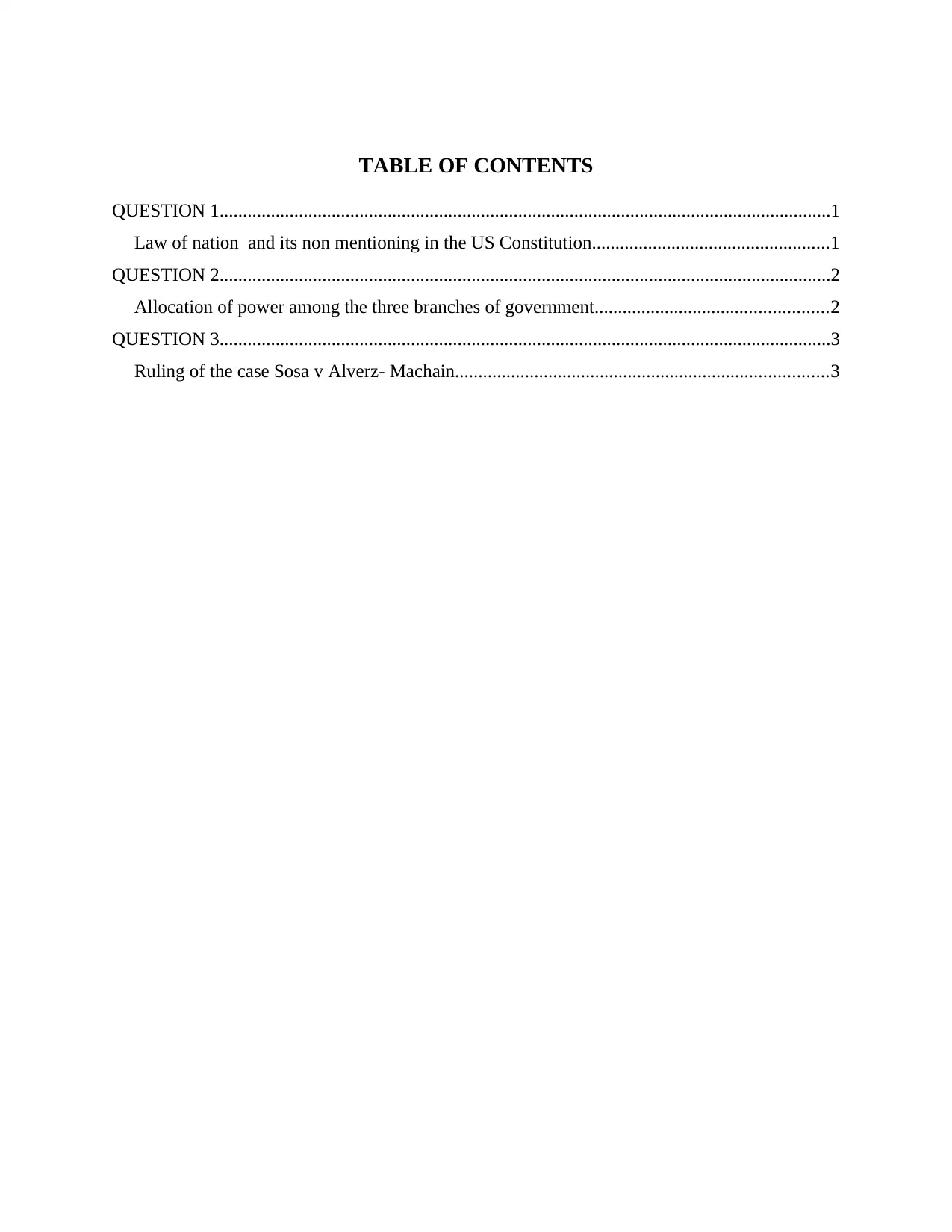
TABLE OF CONTENTS
QUESTION 1...................................................................................................................................1
Law of nation and its non mentioning in the US Constitution...................................................1
QUESTION 2...................................................................................................................................2
Allocation of power among the three branches of government..................................................2
QUESTION 3...................................................................................................................................3
Ruling of the case Sosa v Alverz- Machain................................................................................3
QUESTION 1...................................................................................................................................1
Law of nation and its non mentioning in the US Constitution...................................................1
QUESTION 2...................................................................................................................................2
Allocation of power among the three branches of government..................................................2
QUESTION 3...................................................................................................................................3
Ruling of the case Sosa v Alverz- Machain................................................................................3
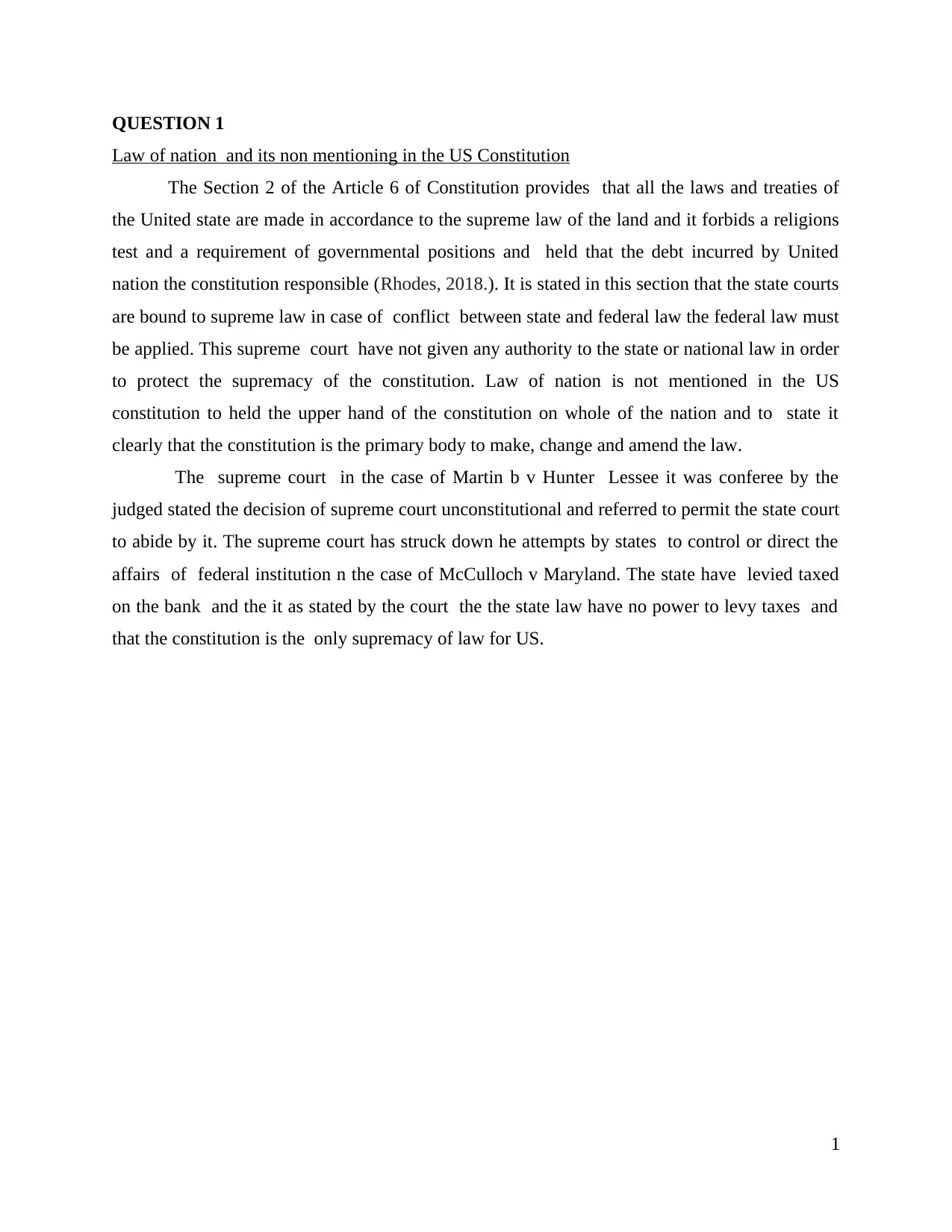
QUESTION 1
Law of nation and its non mentioning in the US Constitution
The Section 2 of the Article 6 of Constitution provides that all the laws and treaties of
the United state are made in accordance to the supreme law of the land and it forbids a religions
test and a requirement of governmental positions and held that the debt incurred by United
nation the constitution responsible (Rhodes, 2018.). It is stated in this section that the state courts
are bound to supreme law in case of conflict between state and federal law the federal law must
be applied. This supreme court have not given any authority to the state or national law in order
to protect the supremacy of the constitution. Law of nation is not mentioned in the US
constitution to held the upper hand of the constitution on whole of the nation and to state it
clearly that the constitution is the primary body to make, change and amend the law.
The supreme court in the case of Martin b v Hunter Lessee it was conferee by the
judged stated the decision of supreme court unconstitutional and referred to permit the state court
to abide by it. The supreme court has struck down he attempts by states to control or direct the
affairs of federal institution n the case of McCulloch v Maryland. The state have levied taxed
on the bank and the it as stated by the court the the state law have no power to levy taxes and
that the constitution is the only supremacy of law for US.
1
Law of nation and its non mentioning in the US Constitution
The Section 2 of the Article 6 of Constitution provides that all the laws and treaties of
the United state are made in accordance to the supreme law of the land and it forbids a religions
test and a requirement of governmental positions and held that the debt incurred by United
nation the constitution responsible (Rhodes, 2018.). It is stated in this section that the state courts
are bound to supreme law in case of conflict between state and federal law the federal law must
be applied. This supreme court have not given any authority to the state or national law in order
to protect the supremacy of the constitution. Law of nation is not mentioned in the US
constitution to held the upper hand of the constitution on whole of the nation and to state it
clearly that the constitution is the primary body to make, change and amend the law.
The supreme court in the case of Martin b v Hunter Lessee it was conferee by the
judged stated the decision of supreme court unconstitutional and referred to permit the state court
to abide by it. The supreme court has struck down he attempts by states to control or direct the
affairs of federal institution n the case of McCulloch v Maryland. The state have levied taxed
on the bank and the it as stated by the court the the state law have no power to levy taxes and
that the constitution is the only supremacy of law for US.
1
⊘ This is a preview!⊘
Do you want full access?
Subscribe today to unlock all pages.

Trusted by 1+ million students worldwide
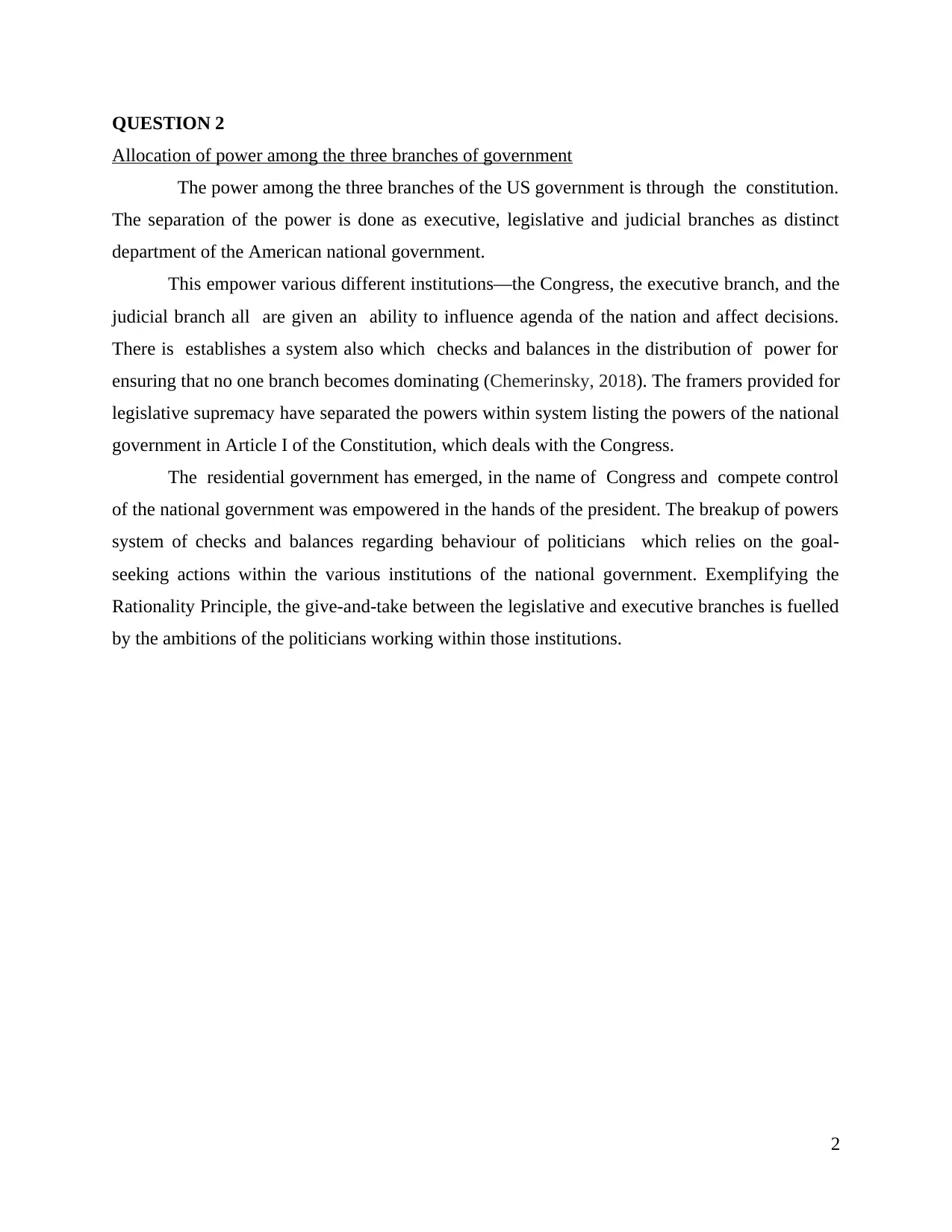
QUESTION 2
Allocation of power among the three branches of government
The power among the three branches of the US government is through the constitution.
The separation of the power is done as executive, legislative and judicial branches as distinct
department of the American national government.
This empower various different institutions—the Congress, the executive branch, and the
judicial branch all are given an ability to influence agenda of the nation and affect decisions.
There is establishes a system also which checks and balances in the distribution of power for
ensuring that no one branch becomes dominating (Chemerinsky, 2018). The framers provided for
legislative supremacy have separated the powers within system listing the powers of the national
government in Article I of the Constitution, which deals with the Congress.
The residential government has emerged, in the name of Congress and compete control
of the national government was empowered in the hands of the president. The breakup of powers
system of checks and balances regarding behaviour of politicians which relies on the goal-
seeking actions within the various institutions of the national government. Exemplifying the
Rationality Principle, the give-and-take between the legislative and executive branches is fuelled
by the ambitions of the politicians working within those institutions.
2
Allocation of power among the three branches of government
The power among the three branches of the US government is through the constitution.
The separation of the power is done as executive, legislative and judicial branches as distinct
department of the American national government.
This empower various different institutions—the Congress, the executive branch, and the
judicial branch all are given an ability to influence agenda of the nation and affect decisions.
There is establishes a system also which checks and balances in the distribution of power for
ensuring that no one branch becomes dominating (Chemerinsky, 2018). The framers provided for
legislative supremacy have separated the powers within system listing the powers of the national
government in Article I of the Constitution, which deals with the Congress.
The residential government has emerged, in the name of Congress and compete control
of the national government was empowered in the hands of the president. The breakup of powers
system of checks and balances regarding behaviour of politicians which relies on the goal-
seeking actions within the various institutions of the national government. Exemplifying the
Rationality Principle, the give-and-take between the legislative and executive branches is fuelled
by the ambitions of the politicians working within those institutions.
2
Paraphrase This Document
Need a fresh take? Get an instant paraphrase of this document with our AI Paraphraser
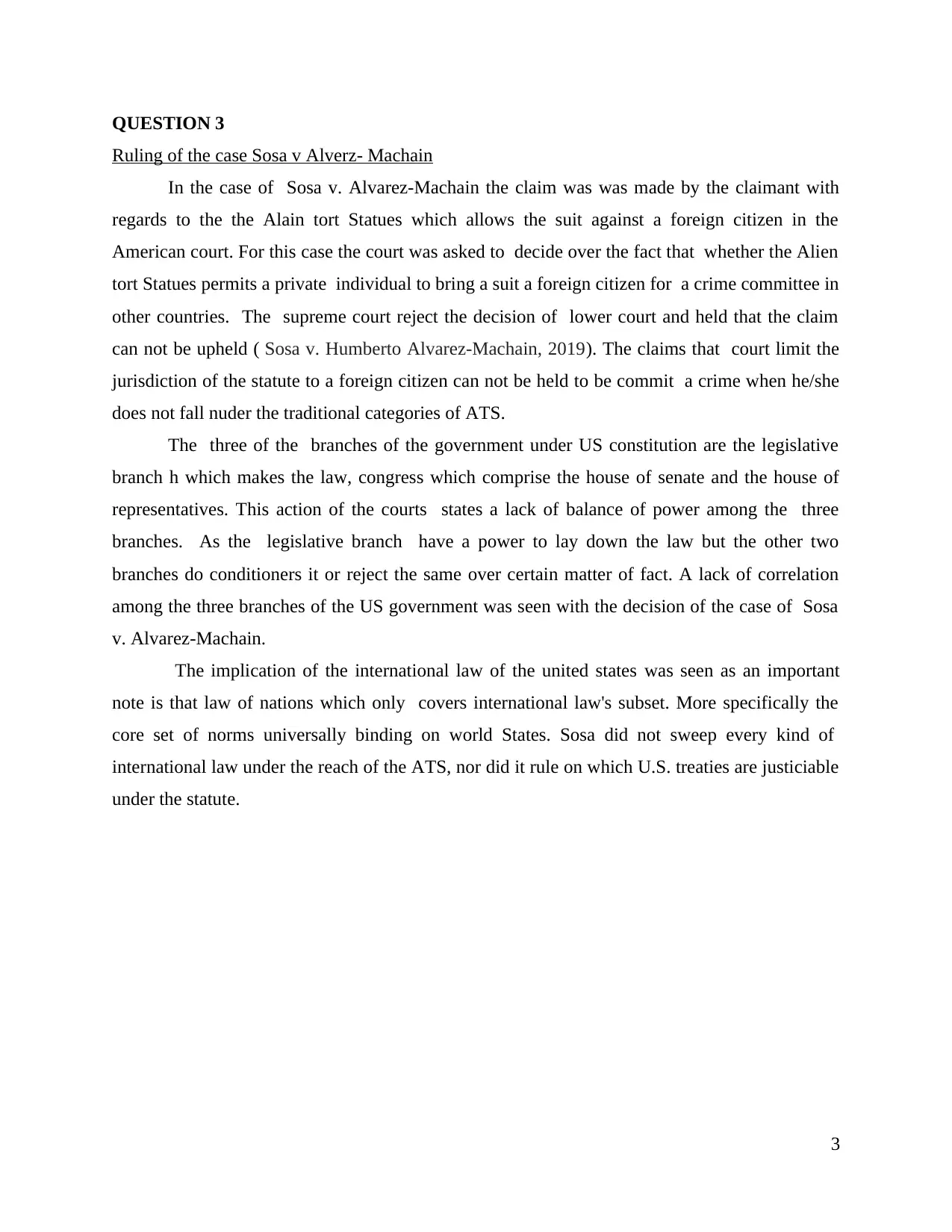
QUESTION 3
Ruling of the case Sosa v Alverz- Machain
In the case of Sosa v. Alvarez-Machain the claim was was made by the claimant with
regards to the the Alain tort Statues which allows the suit against a foreign citizen in the
American court. For this case the court was asked to decide over the fact that whether the Alien
tort Statues permits a private individual to bring a suit a foreign citizen for a crime committee in
other countries. The supreme court reject the decision of lower court and held that the claim
can not be upheld ( Sosa v. Humberto Alvarez-Machain, 2019). The claims that court limit the
jurisdiction of the statute to a foreign citizen can not be held to be commit a crime when he/she
does not fall nuder the traditional categories of ATS.
The three of the branches of the government under US constitution are the legislative
branch h which makes the law, congress which comprise the house of senate and the house of
representatives. This action of the courts states a lack of balance of power among the three
branches. As the legislative branch have a power to lay down the law but the other two
branches do conditioners it or reject the same over certain matter of fact. A lack of correlation
among the three branches of the US government was seen with the decision of the case of Sosa
v. Alvarez-Machain.
The implication of the international law of the united states was seen as an important
note is that law of nations which only covers international law's subset. More specifically the
core set of norms universally binding on world States. Sosa did not sweep every kind of
international law under the reach of the ATS, nor did it rule on which U.S. treaties are justiciable
under the statute.
3
Ruling of the case Sosa v Alverz- Machain
In the case of Sosa v. Alvarez-Machain the claim was was made by the claimant with
regards to the the Alain tort Statues which allows the suit against a foreign citizen in the
American court. For this case the court was asked to decide over the fact that whether the Alien
tort Statues permits a private individual to bring a suit a foreign citizen for a crime committee in
other countries. The supreme court reject the decision of lower court and held that the claim
can not be upheld ( Sosa v. Humberto Alvarez-Machain, 2019). The claims that court limit the
jurisdiction of the statute to a foreign citizen can not be held to be commit a crime when he/she
does not fall nuder the traditional categories of ATS.
The three of the branches of the government under US constitution are the legislative
branch h which makes the law, congress which comprise the house of senate and the house of
representatives. This action of the courts states a lack of balance of power among the three
branches. As the legislative branch have a power to lay down the law but the other two
branches do conditioners it or reject the same over certain matter of fact. A lack of correlation
among the three branches of the US government was seen with the decision of the case of Sosa
v. Alvarez-Machain.
The implication of the international law of the united states was seen as an important
note is that law of nations which only covers international law's subset. More specifically the
core set of norms universally binding on world States. Sosa did not sweep every kind of
international law under the reach of the ATS, nor did it rule on which U.S. treaties are justiciable
under the statute.
3
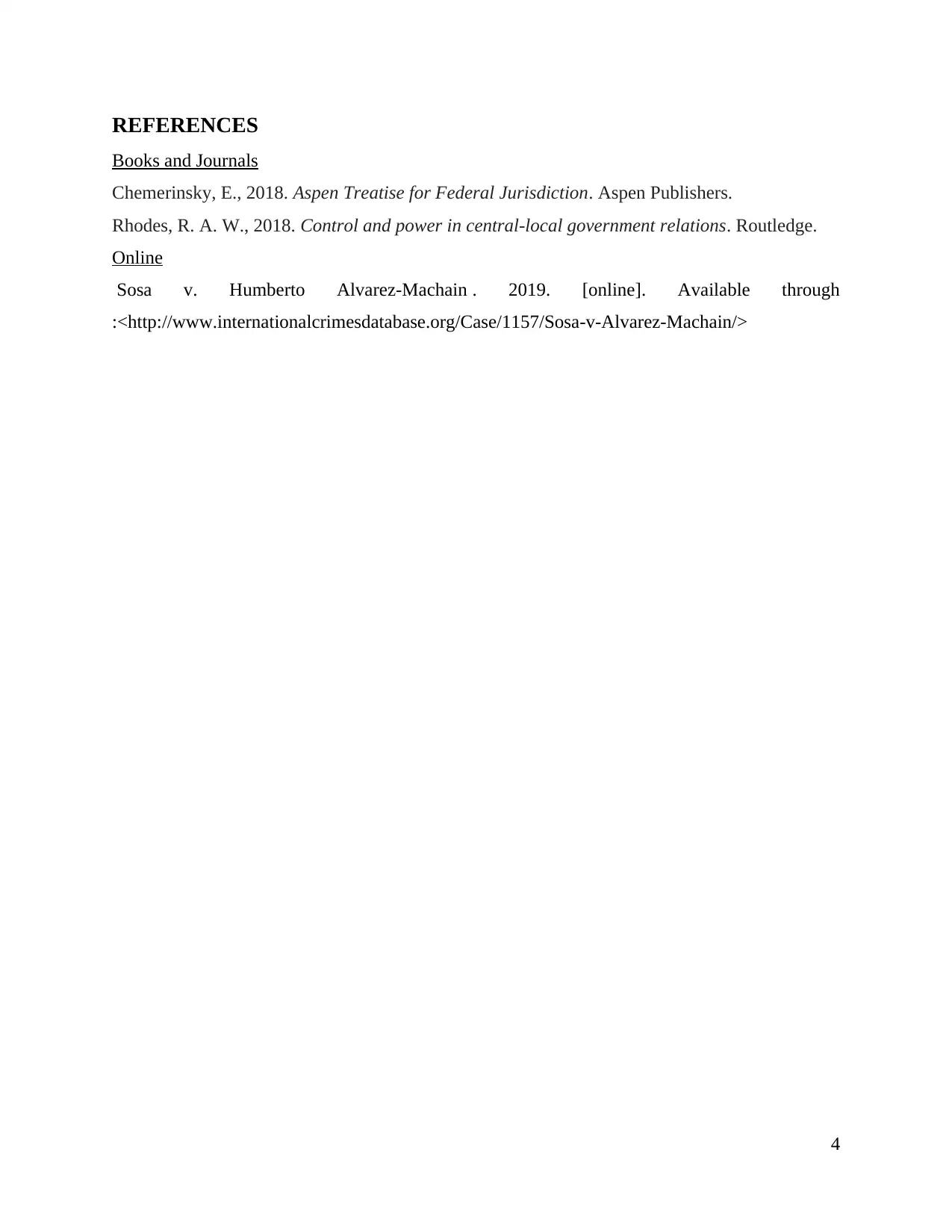
REFERENCES
Books and Journals
Chemerinsky, E., 2018. Aspen Treatise for Federal Jurisdiction. Aspen Publishers.
Rhodes, R. A. W., 2018. Control and power in central-local government relations. Routledge.
Online
Sosa v. Humberto Alvarez-Machain . 2019. [online]. Available through
:<http://www.internationalcrimesdatabase.org/Case/1157/Sosa-v-Alvarez-Machain/>
4
Books and Journals
Chemerinsky, E., 2018. Aspen Treatise for Federal Jurisdiction. Aspen Publishers.
Rhodes, R. A. W., 2018. Control and power in central-local government relations. Routledge.
Online
Sosa v. Humberto Alvarez-Machain . 2019. [online]. Available through
:<http://www.internationalcrimesdatabase.org/Case/1157/Sosa-v-Alvarez-Machain/>
4
⊘ This is a preview!⊘
Do you want full access?
Subscribe today to unlock all pages.

Trusted by 1+ million students worldwide

5
1 out of 7
Related Documents
Your All-in-One AI-Powered Toolkit for Academic Success.
+13062052269
info@desklib.com
Available 24*7 on WhatsApp / Email
![[object Object]](/_next/static/media/star-bottom.7253800d.svg)
Unlock your academic potential
Copyright © 2020–2025 A2Z Services. All Rights Reserved. Developed and managed by ZUCOL.





